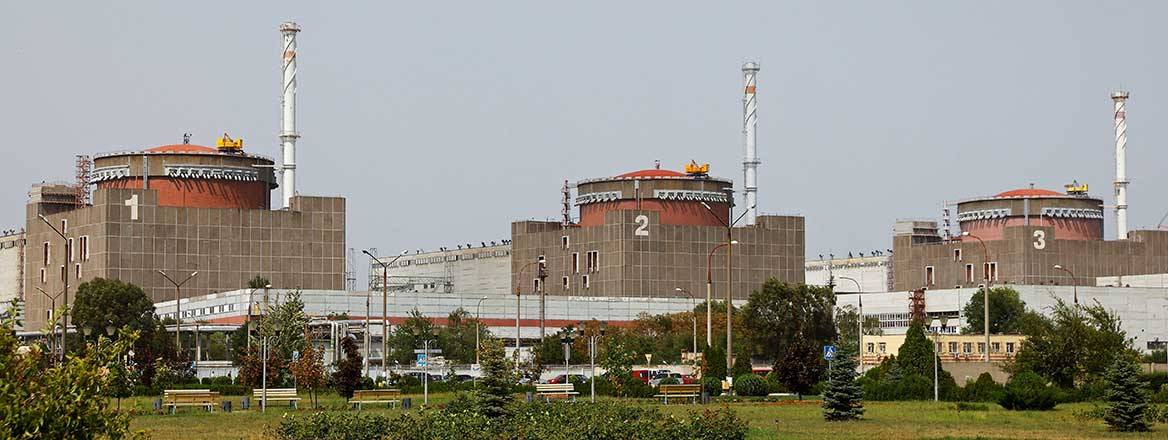Darya Dolzikova and Dr Jack Watling

The war in Ukraine has underlined the need to enhance the safety and security of nuclear power plants in war zones.
Russia’s full-scale invasion of Ukraine on 24 February 2022 saw the immediate capture by Russian forces of Ukraine’s Chornobyl Nuclear Power Plant (ChNPP). A few days later, Russian forces attacked the Zaporizhzhia Nuclear Power Plant (ZNPP) – the first instance of an operational nuclear power plant (NPP) directly targeted as part of a military operation. Over the past year, Russia’s military activity in Ukraine has resulted in serious threats to the safety and security of Ukraine’s nuclear infrastructure, and there is good reason to believe that Russia has violated the protections granted to NPPs in international humanitarian law (IHL). Given the significant projected global increase in the number of nuclear reactors over the coming decades, it is likely that this will not be the last time NPPs are in the midst of military conflict. This report seeks to assess the risks the ongoing war poses to NPPs in Ukraine and to draw preliminary conclusions from these events to improve the safety and security of NPPs in conflict.
The greatest threat to Ukraine’s NPPs is unlikely to be from a direct strike on a reactor and an ensuing large-scale radiological incident similar to the 1986 Chornobyl disaster, but rather the failure of key systems – namely, water and energy supply – or human error, potentially resulting in an incident not unlike what occurred at Fukushima Daiichi NPP in 2011. The threat of direct strike is more of a concern when it comes to the pool-type spent nuclear fuel storage or the sarcophagus containing the remnants of the destroyed Unit 4 at the ChNPP, which are not designed to be as robust as the containment structures over the operating reactors. There is also a risk that Ukraine may run out of available storage for its used nuclear fuel as it cannot currently transport spent fuel safely. Finally, the possibility that Russia may manufacture a radiological incident at the ZNPP or another facility to spoil a Ukrainian offensive should not be disregarded.
This report makes three sets of recommendations. The first relates to mitigating the immediate risks posed to nuclear infrastructure in Ukraine. The second relates to strengthening regulations, standards and other considerations to mitigate against potential threats to nuclear safety and security in conflict. The third relates to the conduct of military operations around NPPs.
To improve nuclear safety and security in Ukraine, the international community should:Ensure the personal safety and welfare of staff at NPPs, including sufficient staffing levels.
Ensure sufficient licensed Ukrainian staff are ready to resume operations at the ZNPP following Russian withdrawal from the facility.
Facilitate the safe transport of spent nuclear fuel to dry-storage facilities, where appropriate.
Assess availability of highly radioactive waste storage facilities and certify additional storage if needed.
Provide chemical, biological, radiological and nuclear, emergency response and other necessary equipment, training and support to the Ukrainian military, emergency services and NPP operators.
Provide regular updates on the supply of fuel for emergency generators at Ukrainian nuclear facilities, as well as the water levels in the Kakhovka Reservoir.
Ensure the safe supply of diesel fuel, maintenance parts and services, and other materials necessary for the safe operation of Ukraine’s NPPs.
Penalise Rosatom staff operating at the ZNPP for participating in Russia’s occupation of Ukraine.
Establish deterrence against a deliberately manufactured radiological incident by making clear to Russia that any such incident would be followed by a massive response to mitigate damage and expanded support for Ukraine’s war effort.
To mitigate against potential threats to nuclear safety and security in future conflict, the international community should:Consider, and adopt the necessary prevention and mitigation measures for, state-level military conflict and occupation of nuclear facilities by an invading force as part of national threat assessments, design-basis threats and wider national defence and security planning.
Include considerations on military attack and occupation of nuclear facilities in the International Atomic Energy Agency’s nuclear safety and security standards.
Harden physical protections in the design of new NPPs.
Harden existing NPPs.
To ensure the safety and security of NPPs in areas of active operations, the international community should:Establish a 1-km demilitarised zone around NPPs.
Grant special protected status to critical NPP safety, security and emergency response systems.
Define an obligation for the establishment of deconfliction lines by militaries operating around NPPs, as well as the nuclear regulators or other responsible authorities in the concerned states.
Establish regulations relating to effects of cyber and electromagnetic activities applied in the vicinity of NPPs.
No comments:
Post a Comment